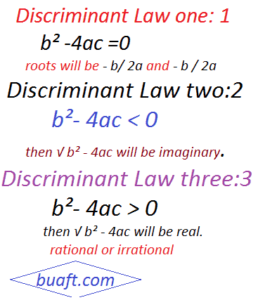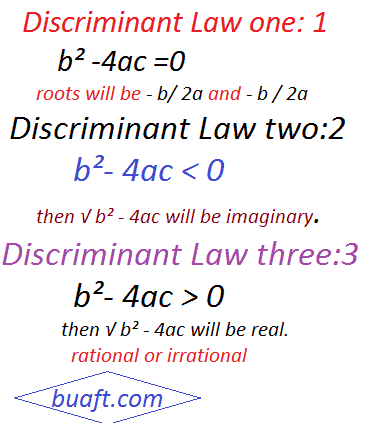Discriminant Laws of any Equation:The nature of the roots of an equation depend on the value of the expression b² -4ac, which is called its discriminant.

Discriminant Law one: 1
If b² -4ac =0 then the roots will be – b/ 2a and – b / 2a
So the roots are real and repeated equal.
Discriminant Law two: 2
If the roots b²- 4ac < 0 then √ b² – 4ac will be imaginary.
So the roots are complex / imaginary and distinct/unequal.
Discriminant Law three: 3
If the roots b²- 4ac > 0 then √ b² – 4ac will be real.
However, If b² – 4ac is a perfect square then √ b² – 4ac will be rational, and irrational
So the roots are rational, otherwise irrational.
Examples:
Discriminant Laws of any Equation.
We discuss the Discriminant Laws of any expression.
(1) x² + 2x + 3 = 0 (2) 2 x² + 5x -1 =0
(3) x² -7x + 3 = 0 (4) 9 x² -12x +4 =0
Solution:
(1) x² + 2x + 3 = 0
Comparing x² + 2x + 3 = 0 with Ax ² +bx +c= 0, we have
a =1, b = 2, c = 3
Disc = b² – 4ac
Disc = (2)² – 4(1)(3)= -8 < 0
Disc < 0
See discriminant Law two (2)
therefore, the roots are complex /imaginary/unequal.
(2) 2 x² + 5x -1 =0
Comparing 2 x² + 5x -1 = 0 with Ax ² +bx +c= 0, we have
a =2, b = 5, c =-1
Disc = b² – 4ac
Disc = (5)² – 4(2)(-1)=25+ 8 =33
Disc > 0 (means discriminant greater than zero)
See discriminant Law Three (3)
So the roots are irrational and unequal.
Solution :
(3) x² -7x + 3 = 0
Comparing 2 x² -7x +3 = 0 with Ax ² +bx +c= 0, we have
a =2, b = -7, c = 3
Disc = b² – 4ac
Disc = (-7)² – 4(2)(3)=49-24=25=5²
Disc >0
Therefore, the roots are real and unequal.
Solution:
(4) 9 x² -12x +4 =0
Comparing 9x² -12x + 4 = 0 with Ax ² +bx +c= 0, we have
a =9, b =-12, c = 4
Disc = b² – 4ac
Disc = (-12)² – 4(9)(4)= 144-144 = 0
Disc = 0
See discriminant Law one (1)
Therefore, the roots are real and equal.
RELATED POST:
- Cube root of unity power
- Fourth roots of unity power
- log x is undefined at x equal to 0
- linear inequalities in ordered pair
